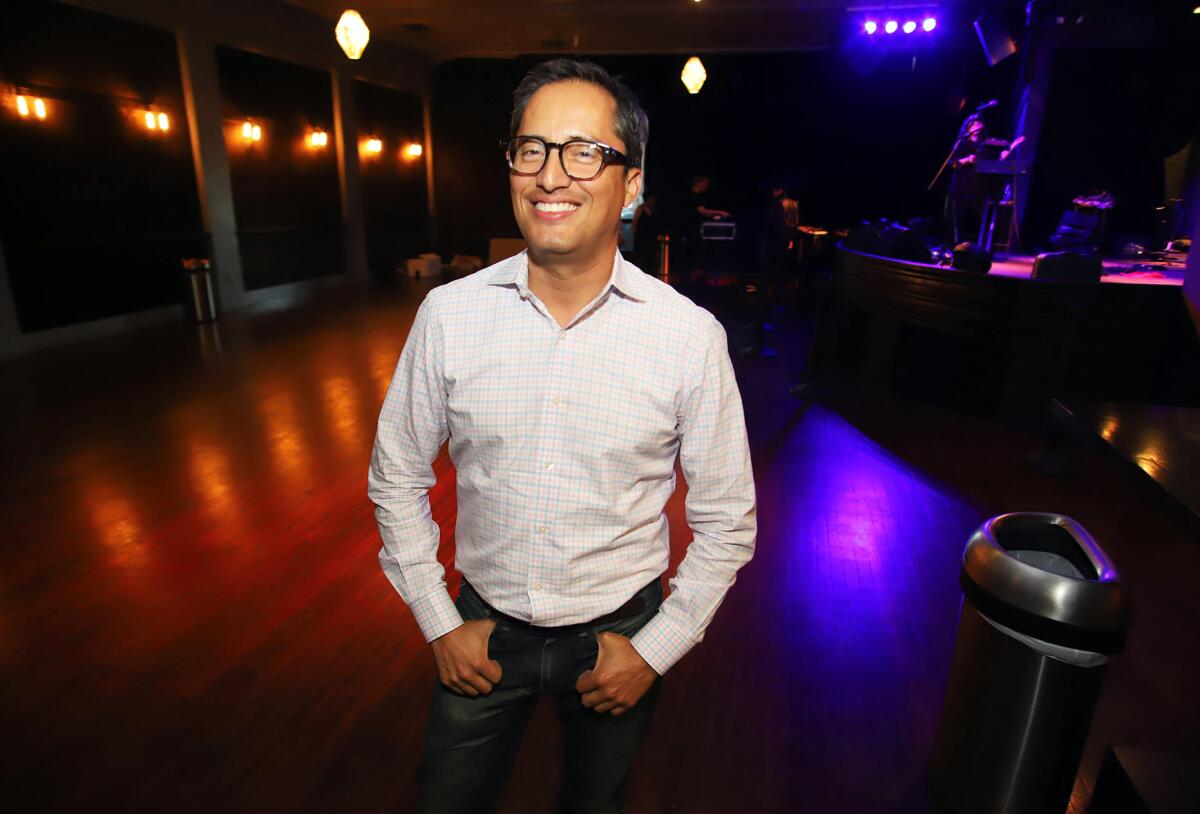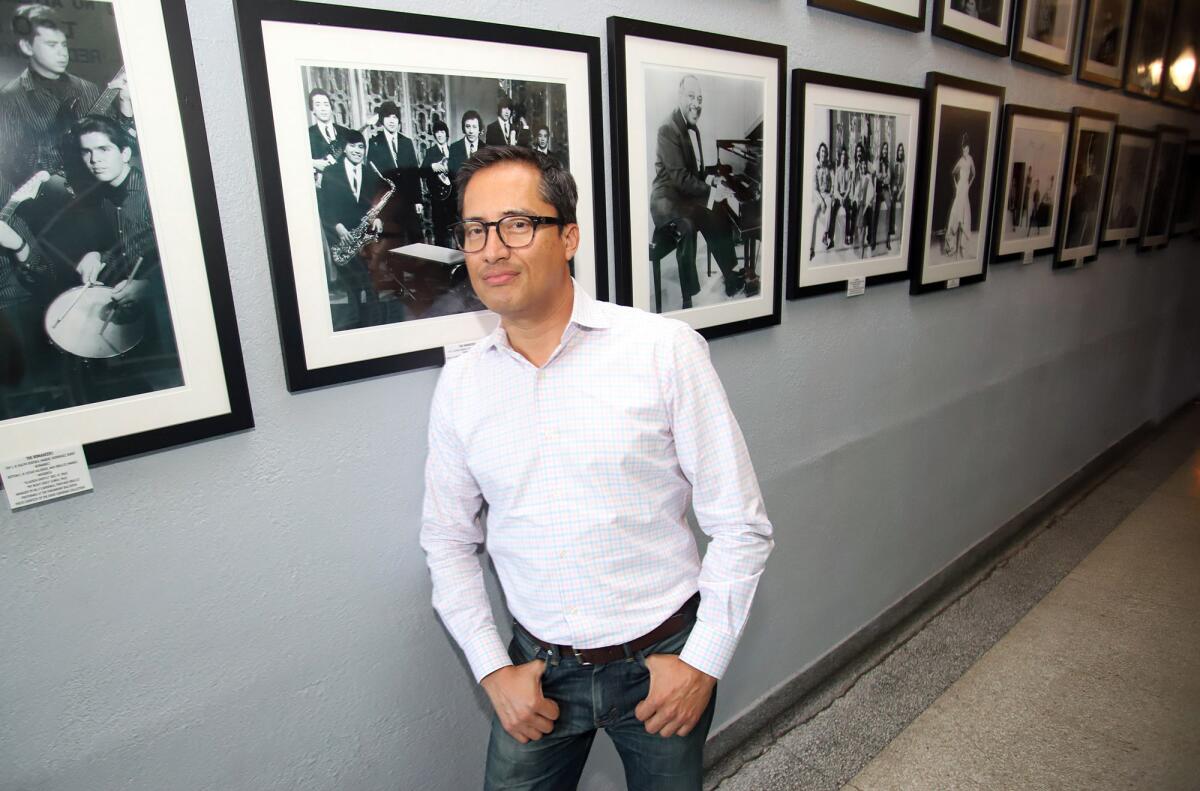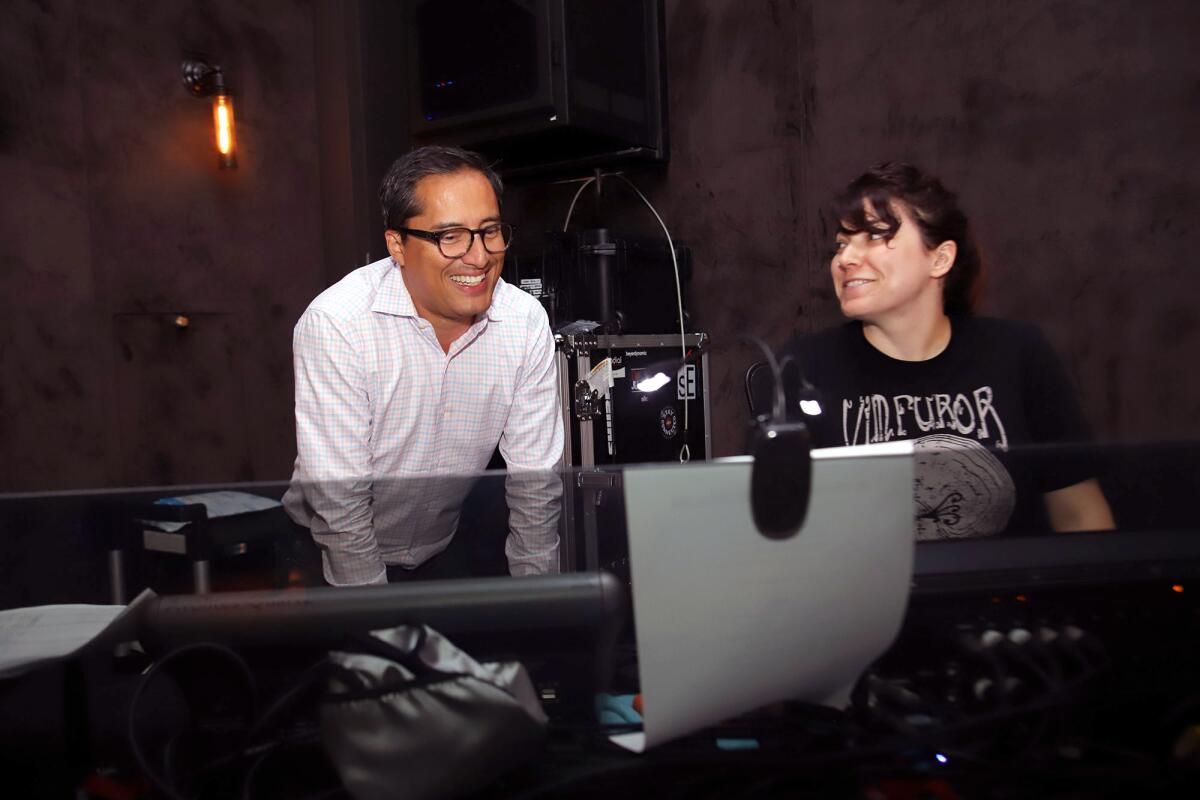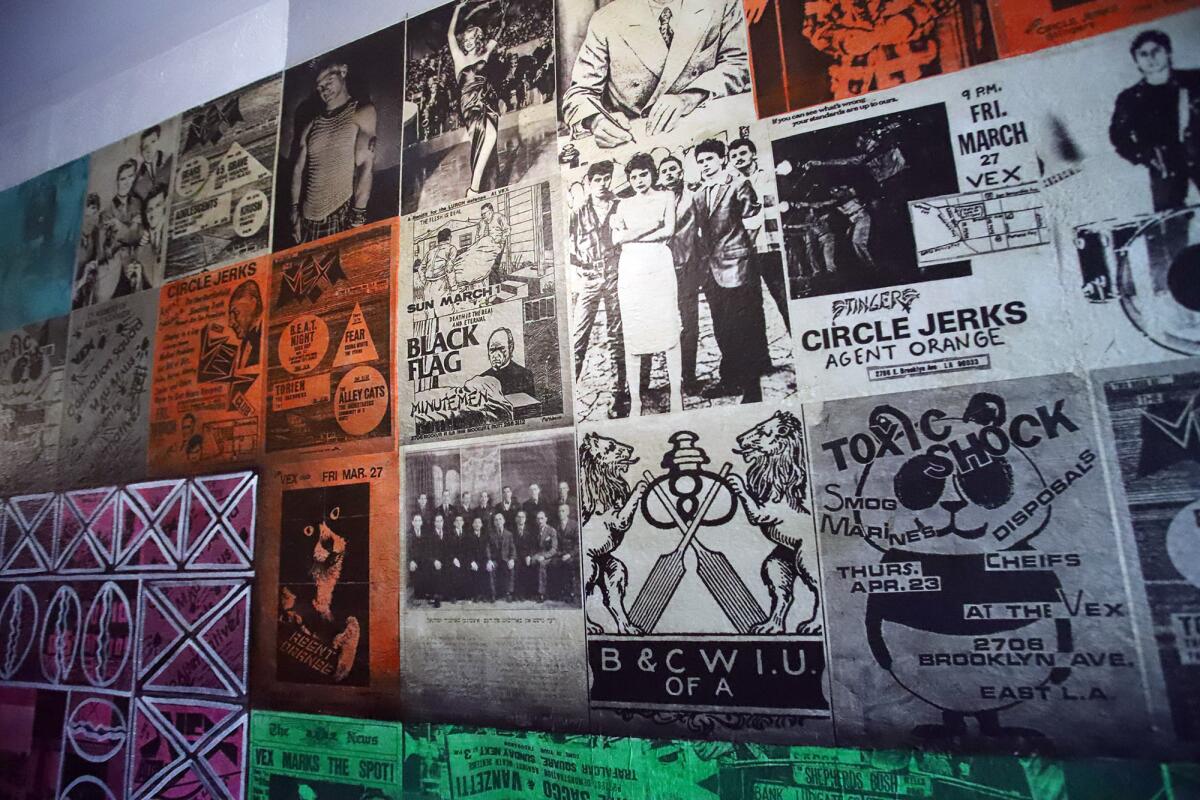An immigrant’s dream makes an iconic Boyle Heights music venue flow with ‘body rhythm’

- Share via
The clock is poised to strike 8, and as businesses along East César Chávez Avenue and Mott Street in Boyle Heights shutter their doors, streetlights illuminate a three-story red brick building where the party is just warming up.
Or, you could say, the Paramount Ballroom is rekindling the good times that caught fire eight decades ago.
Little by little, pachucos, swingers, break dancers, cumbiamberos and punks stroll out from the four corners of the neighborhood to meet at the historic dance hall, where everyone from Benny Goodman to Stevie Wonder, Sonny and Cher to Da Brat and La Santa Cecilia, have lit up the night and filled up the dance floor. A local punk rock band, a cumbia ensemble, a breakout Spanish-language pop artist or a jazz quartet might transfix the room at any given moment.
What happens here can’t be described with words but must be felt “with the rhythm of the body,” patrons say. But the dream of reviving the Paramount wouldn’t have been realized at all if not for an immigrant boy, Frank Acevedo, who grew up poor in L.A.’s Rampart district yearning for more places where low-income youths could find a community resource center, an education annex and a Latino party central — all rolled into one.
Acevedo, 47, remembers when the Radiotron — the only safe entertainment space for youths in his MacArthur Park neighborhood — was demolished by the city of Los Angeles in 1985, when he was 11. The Radiotron youth center gave kids and teens a chance to get together, sing hip-hop and show off their break dance moves. But when the owner sold the property, Acevedo and hundreds like him suddenly found themselves out on the street.

“From feeling like a cool kid I went on to feel devastated by the closure of the center,” recalled the native of Medellín, Colombia. “I was wondering, why close a healthy recreation center and not a bar or a liquor store?”
Since he took over the building that houses the Paramount Ballroom in 2004, Acevedo has invested $800,000 and countless hours of labor in it. The first signs of revival took place on the first floor, where in 2010 he opened the Boyle Heights Arts Conservatory, a nonprofit offering free music lessons in guitar, piano, keyboards, trumpet and DJ-ing.
“We wanted to emulate the Radiotron vibe, which was a place of inspiration that provided a sense of belonging and where people saw themselves as artists,” Acevedo said.
Later, the conservatory added services to enable young people and entire families to acquire and develop skills in radio production, podcasting, music and digital content creation, and photography. Carmelita Ramírez Sánchez, the conservatory’s current director, said that the institution has served about 8,000 students, many drawn from Los Angeles County juvenile detention centers.
“We feel that it is important to work with this sector also, because they are young people who return to the community and need to know that they have support,” Ramírez Sánchez said.

But the centerpiece of Acevedo’s dream was to restore the Paramount Ballroom for new generations of music lovers. Even a partial pandemic-related shutdown between April 2020 and October 2021 hasn’t dimmed his ardor.
“I don’t want the history of Boyle Heights to disappear,” Acevedo said.
The bustle is back
One recent night at the Paramount got rolling with the DJ collective La Junta, then segued to a four-person team of Mexican, Japanese and Filipino heritage — Degruvme, Yukicito, Glenn Red and Prescilla C. — who whipped up a concoction of tropical dance sounds.
Against a backdrop of flashing yellow lights, clinking glasses and booming speakers, Angel Peaches — sultry-voiced daughter of Doris Montenegro of the Mexican and Colombian group La Sonora Dinamita — slunk onto the stage as dancers shuffled across the original 1920s hardwood floor.
Mauricio Pérez, 28, a downtown L.A. resident dressed pachuco-style, acknowledged that he hadn’t known until recently about the building’s storied past.
“A friend of mine brought me here, and upon entering I fell in love with the place not only for how it looks, but for its history,” said the electrician and self-described lover of Chicano history.
What Pérez, the son of Mexican immigrants, values most about the Paramount, which can pack in about 400 people, is the ethnic diversity of both its music and its clientele.
“The vibe is difficult to describe,” he said, wiping sweat from his forehead with a handkerchief. “The rhythm of the body tells you everything.”
As Angel Peaches wrapped up her set and the Riverside group El Santo Golpe flooded the hall with its cumbia-son jarocho-Garifuna fusions, Maria Álvarez, 42, joined in, singing at the top of her lungs. A fan of ‘50s and ‘60s rock and the vintage pinup girl look, Álvarez, who has worked as a nanny since arriving in the U.S. two decades ago, praised projects like the Paramount that preserve Boyle Heights’ cultural identity amid the gentrification onslaught.
“We see investors building apartments that displace the poor. We hardly ever see investors creating nonprofits, reclaiming the past and reestablishing the music culture,” she said, adjusting her skintight black dress and Rita Hayworth-inspired hairdo.
A retro-vintage spirit suits the Paramount. Its earliest incarnations in the 1920s included a stint as a Jewish bakers’ union. During the Great Depression, it turned into a soup kitchen, and as the economy began to recover in the late 1930s, it was transformed into a ballroom. Concerts began in 1939 with Count Basie’s jazz orchestra, the first time an all-Black band was allowed to perform in Boyle Heights.

For the next several decades, the building shook with appearances by Benny Goodman; Don Tosti (best-known for his song “Pachuco Boogie”); Little Julián Herrera, the first Chicano R&B singer; and salsa giants like Celia Cruz and Tito Puente. The 1960s and ‘70s brought Chicano rock groups like Cannibal and the Headhunters and Thee Midniters, followed by Los Illegals and Thee Undertakers in the 1980s.
Tony Valdez, who as a teenager in the early 1960s served as the Paramount’s master of ceremonies before he went on to become a reporter with KTTV-TV Channel 11, said that most local bands and their audiences were made up of low-income Latino youths.
“The war in Vietnam had started, and we all knew or knew of someone who had been drafted, had been killed or had come back wounded,” said Valdez, who grew up in the Estrada Courts housing project. “So music was a way of escaping, of thinking there was hope.”
Rubén Funkahuatl Guevara, a former singer with the Apollo Brothers and the Jets and a longtime Boyle Heights resident who has assisted Acevedo’s research into the building’s history, said he’s not sure who owned the Paramount after its final concerts took place there in the 1980s. But he knows what the club’s restoration means.
“Seeing all that diversity in the same room is a source of pride,” Guevara said, “because it shows Boyle Heights as a community that opens its hands to all immigrants and all people.”
Walls thick with legacy
Two events prefigured the dusting off of the Paramount. One was Acevedo’s parents emigrating with their family from Colombia in 1976. The second was the 1992 Los Angeles riots.
Neither Alcira Acevedo nor her husband, Jorge, could speak English when they arrived in the Rampart neighborhood. But their jobs as aircraft factory machinists allowed them to provide for their three young sons: Jorge, 5; year-old Brian; and Frank, 2.
Although the couple’s budget was tight, there could be no turning back to war-ravaged Colombia. In Los Angeles, they found a supportive community of mostly Mexican, Salvadoran and Guatemalan immigrants who shared a love of music, dance, parties and soccer.
While several friends strayed into L.A.’s gang life, Acevedo kept a straight path as an active Boy Scout from ages 9 to 13. When Radiotron shut down, he began DJ-ing and promoting rave parties.
“I wanted to represent the Latino community and make sure that I always provided them with a festive atmosphere,” he said.
His sense of purpose changed in April 1992 after a jury acquitted four Los Angeles Police Department officers in the beating of Black motorist Rodney King and the city erupted in flames.
“I understood people’s frustration at the lack of justice, community services and police abuse against minorities,” Acevedo recalled. He took part in demonstrations and left his job organizing music events to enroll in Glendale Community College while working as an office manager for a real estate investment company. In 1995, at age 21, Acevedo started his own business, Rampart Properties, and in 2004 he acquired the Paramount, which had been renamed the Casa Grande.
It took years of structural repairs and enhancements to get the Paramount ready for its Instagram moment in August 2019. As customers enter today, they cruise past collages of headshots and signed posters of the countless artists who’ve left their mark.
José Galván, who selects and books musical talent for the Paramount, takes pride in offering a performance space to both established and emerging artists.
“There are many Latin groups that are very talented, but many venues don’t give them the opportunity to make their music known,” Galván said.
The opening of the Paramount has stirred memories for those who once performed there, like Chicano vocalist Little Willie G. (Willie Garcia). Back in the day, he and his band Thee Midniters could be heard pumping out “Land of a Thousand Dances” — with its immortal chorus of “naa, na, na, na naa” — from homes and cars across L.A.
“There were some really good bands that played at the Paramount in the ‘60s,” said Willie G, 76, who grew up in what was then called South-Central Los Angeles. “The place was sophisticated, a five-star avenue, full of glamour.”
For every song he performed, Willie G. earned $1, at a time when a hamburger cost 15 cents.
“We ate at a restaurant called Largos Mitote near East L.A. College, and when we had more money we would go to Vivian’s restaurant on Atlantic and Whittier Boulevard,” he said with a laugh.
Neighboring businesses also are heartened by the dance hall’s resurrection.
“People who live in Boyle Heights don’t have the need to go out for fun,” said Felix Gastelum, whose Felix the Cat Barber Shop, next door to the Paramount, has been around for nearly 30 years. “Places like the Paramount bring in people from other cities, which exposes us to new customers.”
For Acevedo, the legacy he most wants to preserve is that of immigrants like him who founded the space all those years ago.
“Now the Paramount shines again with new bands of all ethnicities,” he said. “Not only was a structure repaired, but a story.”
More to Read
The biggest entertainment stories
Get our big stories about Hollywood, film, television, music, arts, culture and more right in your inbox as soon as they publish.
You may occasionally receive promotional content from the Los Angeles Times.











